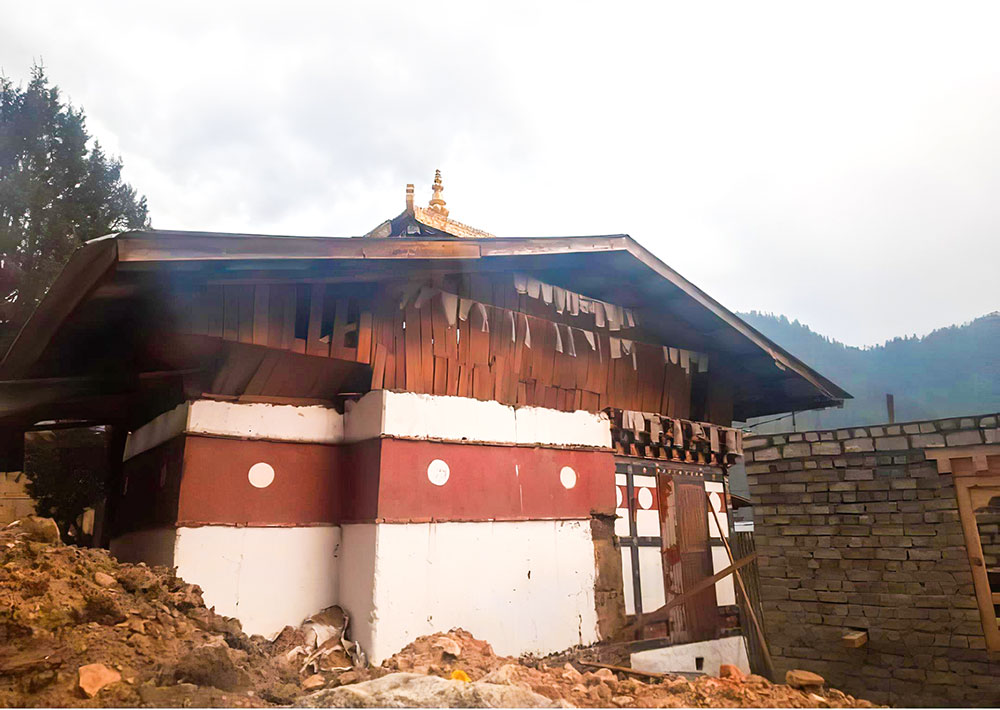A herder and donkey’s journey
Chhimi Dema
Nestled along the road leading to Haa Dzongkhag Court, a hidden gem awaits discovery—the enchanting Bali Lhakhang.
This humble lhakhang holds within its walls a wealth of cultural history that has bound the community of Bali for countless centuries.
As the village elders reminisce, they find themselves unable to pinpoint the exact origins of this sacred place. However, a fascinating legend has been passed down through generations, recounting the story of Bali Lhakhang’s creation—a tale that begins with the fateful visit of a herder and his donkey.
According to local beliefs, Bali Lhakhang faces the Ralung Monastery, now in ruins, located in Tibet. The Ralung Monastery, founded in 1180 by Tsangpa Gyare, the visionary behind the Drukpa Lineage in Tibetan Buddhism, held great significance for the people of Bali.
Legend has it that a wise lama from Ralung Monastery, with his deep spiritual intuition, sensed the auspiciousness of a certain place in Haa. He then dispatched a herder and his faithful donkey on a quest to seek out this sacred location.
Under the scorching sun, the herder and his trusted companion traversed the verdant pasturelands, their weary bodies drenched in sweat. Wiping the perspiration from his brow, the herder realised that the search for the sacred site would prove more arduous than anticipated.
Throughout weeks of tireless travel, the unwavering donkey stood by his master’s side, demonstrating remarkable loyalty. It was not until they arrived beneath the sheltering branches of a majestic cypress tree that the dutiful donkey abruptly halted, fixated on the ground, and began to paw at the earth with its left hoof.
Curiosity piqued, the exhausted herder observed this peculiar behavior. Minutes ticked by until, finally, the donkey’s hoof struck something hidden beneath the soil. The excavation unveiled a drilbu, a sacred bell, buried within the earth.
Overwhelmed by this extraordinary event, the herder sensed that he had stumbled upon the very place his lama had sent him to find. To this day, the broken remnants of that bell can be found within the lhakhang’s hallowed walls, a testament to its remarkable origin.
Nim Chencho, a custodian of the lhakhang, recalls stories passed down by his forefathers, who shared that the lhakhang was constructed by Tibetan craftsmen. “The lhakhang’s architectural design, including the altar, is distinctly Tibetan,” he fondly recollects.
Remarkably, Bali Lhakhang has undergone renovation three times, with the support of the local community and generous sponsors, expanding its original structure. Nim Chencho reveals that the original lhakhang could accommodate no more than three individuals at a time.
Inside the lhakhang, visitors are greeted by statues of Jowo (Maitreya), the revered local deity Dolay, and a tsen, symbolizing the spiritual significance embedded within these sacred walls. Similar Jowo statues can be found in Jampel and Kichu lhakhangs, as well as Aney Goenpa in Mongar.
In the year 659 AD, the esteemed Tibetan King Songtsen Gambo issued a momentous decree: the construction of 108 statues within a single day. This ambitious endeavor was undertaken to quell the influence of a formidable female ogress who sought to impede the propagation of Buddhism.
Among the precious artifacts enshrined within the temple, the revered Jowo Jampa takes center stage. It is widely believed that the Jowo statue housed within the Bali Lhakhang is one of the esteemed 108 statues commissioned by the great Tibetan king.
This magnificent statue stands as a testament to the profound devotion and unwavering commitment of those who safeguarded the teachings of Buddhism, ensuring its endurance throughout the ages.
Nim Chencho reveals that beyond its sacred walls lie numerous Guru Nyes, ancient scriptures revered by the community. He shares an intriguing insight into the origin of the name Bali, explaining, “Our ancestors referred to this place as Ba Yue, a dwelling where the teachings of the Gurus prevailed. However, as time passed, the name evolved, and it became known as Bali.”
Regrettably, Nim Chencho expresses concern over the absence of written records documenting the history of the lhakhang and the Guru Nyes. He fears that the younger generation may fail to grasp the profound significance of these cultural treasures. As oral traditions fade away at an alarming pace, he laments, “We are witnessing the erosion of our intangible heritage.”
Today, the responsibility of preserving this sacred site rests with approximately 25 households who wholeheartedly devote themselves to the well-being of the lhakhang.


